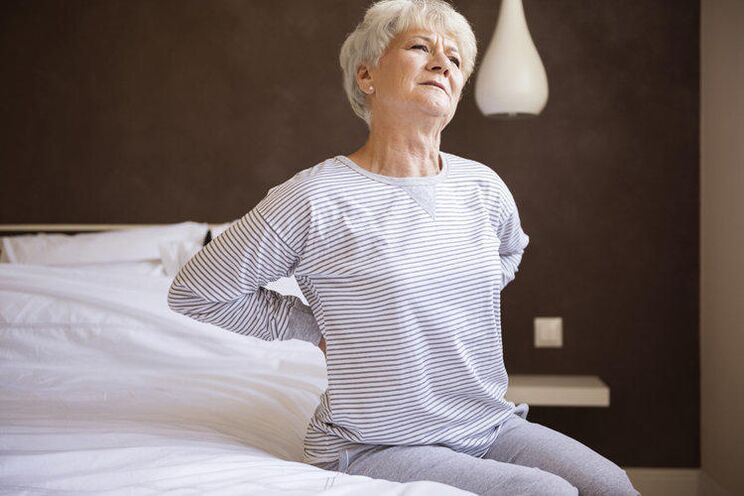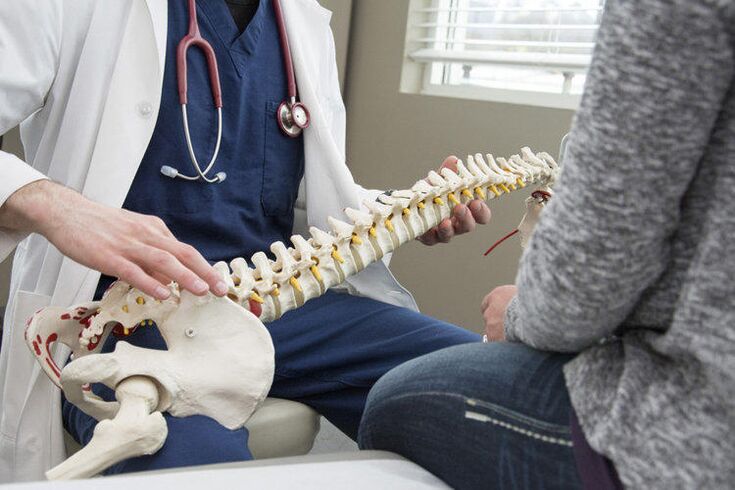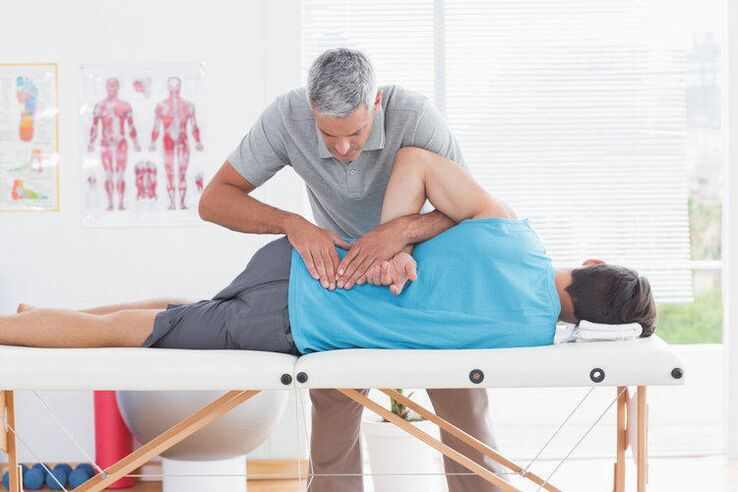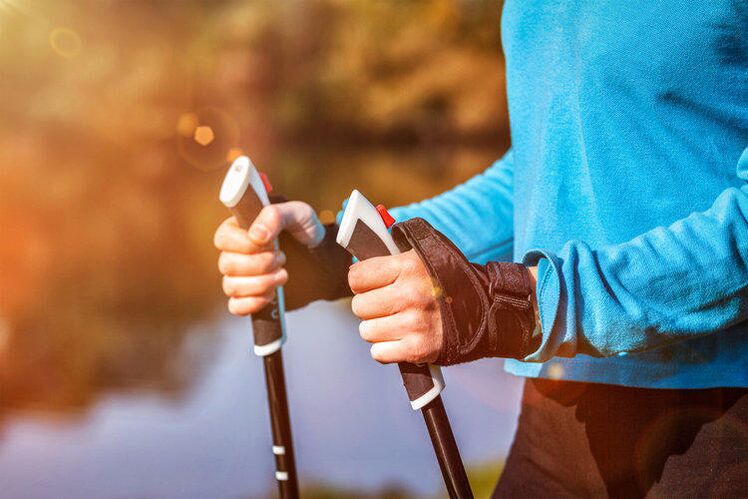Osteochondrosis is an illness in which degenerative dystrophic changes are diagnosed in the cartilage tissue of the spine, which are also accompanied by disorders of the structure and functionality of the intervertebral discs. Depending on the localization of damaged tissue, osteochondrosis of the cervix, thorax and lumbar spine are differentiated.

What is osteochondrosis?
Osteochondrosis is an illness of the spine in which degenerative and dystrophic lesions of the intervertebral discs occur. With the development of osteochondrosis, degenerative-dystrophic lesions for vertebral fabrics apply.
The main feature indicating the development of osteochondrosis is Pain in the Neck, Back, Lower Back Area, with progression, The Pain "Gives" Into the Hands, Chest, Shoulders, Upper Thight, etc. With negative dynamics of osteochondrosis, atrophy of muscle tissue, impaired sensitivity, impairedAs well as dysfunction of the internal organ, provoked by their suppression, provocative, provoked. Shift. In the absence of timely therapy, osteochondrosis develops into an incurable state.
The causes of osteochondrosis
The main factor in the development of osteochondrosis is an uneven strain on the spine. The habit of wearing a bag on a shoulder or in one hand, a false pose in a seated position, a dream on an excessively soft mattress, a high pillow that is anatomically false shoes, are a common cause of improper distribution of the load.
Additional risk factors are hypodynamics, a sitting lifestyle, obesity, back injuries, lower extremities, flat feet and other diseases of the musculoskeletal system as well as age -related degenerative processes in age -related changes in blood supply to the spine.
The following factors can also play a role in the etiology of osteochondrosis:
- Physical overvoltage of the body;
- neuro-emotional exhaustion;
- Metabolic disorders, poisoning, diseases of the gastrointestinal tract that prevent the full assimilation of nutrients;
- In particular, professional risks work on vibration platforms;
- genetic predisposition;
- Violations of attitude during active growth, scoliosis;
- Wear unpleasant shoes (cramped, paragraphs);
- longer and/or regular dehydration;
- Inferior diet, hypovitaminosis;
- Smoke;
- Pregnancy, especially several, in combination with an undeveloped muscle league apparatus (due to the shift in the body of the body).
Development stages of osteochondrosis
Osteochondrosis in the dynamics of the disease organizes four stages:

- Osteochondrosis of the 1st stage (degrees) is characterized by the initial stages of the pathology in the pulposkerne of the intervertebral disc. Due to the excessive stress, the process of dehydration (dehydration) of the core begins, which leads to a decrease in the parameter of the height of the disc and the occurrence of cracks in the fibrous ring. The symptoms at this stage are usually missing, with a longer stay in an unpleasant static pose, active movement, etc. , slight symptoms can occur.
- In 2 stadiums, a decrease in the height of the windows leads to a decrease in the distance between the vertebrae and the discontinuation of the vertebrates and ligaments. This leads to an increased mobility of the vertebrae with affected windows, which is dangerous with their shift or slide. In the second stage of the disease, complaints, pain occurs, especially in some types of load, movements, positions;
- Osteochondrosis -3 stages (degrees) are characterized by the formation of prolapses and protrusions of the intervertebral discs, which can be accompanied by subluxis and/or the development of the arthrosis of the band burns. In some types of movements, the patients feel stiffness, inadequate mobility, a feeling of tingling and numbness in the limbs. At this stage, osteochondrosis is clearly felt in the back, in the neck, in the lumbosacral department or in the Coccyx, depending on the localization of the affected windows.
- In 4 stages of osteochondrosis, the body tries to adapt the consequences of the hypermobility of the vertebrae and to adapt to an impaired functionality of the spine. Osteophytes, new bone formations that record the vertebral fixation are formed at the contact locations of the vertebrae. In some cases, however, osteophytes can lead to violations of the nerves and violate the vertebrae. The fibrous ankylose begins in the intervertebral discs and joints. In the absence of microtrauma and violations of nerve roots, the symptoms of the disease decrease.
Symptoms of osteochondrosis
The main symptoms of osteochondrosis are a feeling of symptoms and/or pain in the neck, back. The severity of the sensations and the presence of additional symptoms depend on the stage of the disease. When examining the patient and the collection of an anamnesis, the specialist carries out the initial diagnosis, whereby the presence of osteochondrosis is adopted by visually determined curvature of the spine observed in the transverse or longitudinal level of the spine. The pathologies of the intervertebral discs of the cervix and lumbar spine are much more common than degenerative and dystrophic changes in the area of the chest.
The signs of osteochondrosis that are felt by the patient include a regular or permanent feeling of back tiredness, deleted or pronounced, depending on the stage of the disease. The pain can be localized in the neck, in the back, in the chest, in the shoulder girdle, in the complicated, complicated and the movements of the upper limbs.
The clinical image of osteochondose largely depends on the localization of the pathology, the degree of development of the process, the individual characteristics of patients. The pathology of the intervertebral discs, shifts, lead, hernia and an increase in osteophytes lead to various consequences. Under the most common violations of normal blood circulation in the tissue, the clamping of the nerve end, the dysfunction of the vertebral canal, the edema, the fibrosis of tissues and structures are differentiated.
Such consequences can be accompanied by many different symptoms, which leads to an incorrect diagnosis of diseases.
The most common and characteristic symptoms of osteochondrosis are the following:
- Pain in the back, neck, lower back, shoulder girdle, areas of the ribs;
- Complaints, stiffness of body movements that occur in some positions of the body, inclinations, twists, increased muscle tension;
- A feeling of deafness of the upper and lower extremities;
- Muscle and joint complaints, muscle cramps;
- Headache, dizziness, increased tiredness;
- Pain in the heart;
- Violation of the sensitivity of the hands;
- Muscle hypotension.
The symptoms of osteochondrosis differ depending on the localization of the pathology:
- With osteochondrosis of the cervical spine, pain in the neck, hands, shoulder girdle, which radiate on the shoulder area and the shoulder; Headache, dizziness, flickering of "flying" or spots in front of the eyes, noises in the ears are noted;
- In the event of damage to the thoracic spine, the pain in the chest area, the heart, the inner surface of the shoulder, the area of the armpits, and breathing difficulties is also determined, shortness of breath is possible.
- Osteochondrosis of the lumbosacral spine is shown by pain in the lower back with radiation on the legs, the upper thighs or pelvic organs, sexual dysfunctions are often connected.
Superficial symptoms - fatigue of the back, pain - can not only indicate the presence of osteochondrosis, but also to the addition of other diseases or the development of other pathological processes and disorders that are not connected to the dystrophy of flywheels. The diagnosis of osteochondrosis can only be made by a specialist, and self -mediation with such symptoms is unacceptable.
Diagnosis of osteochondrosis

In order to make a diagnosis, instrumental examination methods are used:
- X -Ray examination of the spine department;
- Myelography;
- Neurological examination of sensitivity, reflexes.
Additional methods for differentiation and clarification of the diagnosis contain the stage of the pathology:
- Computer tomography of the spine (CT);
- Nuclear-Magnetic Resonance (Jamr);
- Magnetic resonance imaging (MRI).
Therapy instructions on osteochondrosis
The treatment is based on an integrated approach and, depending on the stage, takes intensive care and 1 year, in which measures are supported to consolidate the result and the prevention of a relapse.
Osteochondrosis, depending on the degree of osteochondrosis and the patient's health, therapy is carried out for two directions. The conservative treatment of the disease consists of taking medication and a number of exercises. Surgical treatment in almost any situation cannot be the first choice, and is prescribed without positive dynamics, the progression of the disease against the background of longer conservative therapy.
In addition to medical therapy methods, it is necessary to follow the general recommendations for osteochondrosis: observe a diet, take measures required for rehabilitation.
Conservative treatment of osteochondrosis
Conservative therapy aims to stop pain syndrome, normalize the functionality of the spine and prevent negative changes
The conservative treatment of osteochondrosis includes the following types of therapy:
- Pharmaceutical therapy. Medicines for osteochondrosis are used to stop pain syndromes and inflammatory processes in tissues and normalize the body's metabolic processes. In the case of a pronounced pain syndrome, it is recommended to use the pharmaceutical blockage of nerve endings, which also contribute to a decrease in the severity of the muscle tonic syndrome. The following types of blockade are differentiated: blockade of trigger points, intraosseous, facet, paravertebral, epidural;
- Physiotherapy methods. Physiotherapeutic methods help reduce pain, increase the effect of medicinal products, while the rehabilitation period is also used. The most common use of ultrasound waves, magnetic fields, low frequency flows, laser rays, etc.
- Methods of physiotherapy exercises (exercise therapy) and kine therapy. The spice complex with regular and correct execution contributes to correcting the posture, strengthens the muscle corset, the league system, normalizes the muscle function, reduces the compression of nerve fibers and helps to prevent the complications of osteochondrosis. Methods for training therapy and kinesi therapeutic agents aim to normalize metabolic processes, to restore a complete nutrition of the intervertebral discs of the intervertebral discs, which means that the arrangement of the vertebrae and slices between them, uniform distribution of the load in the musculoskeletal system of the musculoskeletal system;
- Massage. Manual massage techniques are used to improve the blood supply to tissues, to relieve muscle cramps and clamps and generally improve blood circulation. Hydromasage as a direction of therapeutic activity in addition to the listed effects contributes to the normalization of the body's nervous system;
- Manual therapy. Methods of manual therapy are selected individually. The point effect on the musculoskeletal system helps to improve blood circulation, improve lymph circulation, improve the metabolism, promote the mobility of the musculoskeletal system, to strengthen the immune system and serve as a means of preventing complications of OSTHOCHONSE.
- Therapy with the method of traction (traction) of the spine with special devices. The purpose of manipulations is to increase the band tray on normal parameters, correction of violations of the structure of the spine.
Prevention of osteochondrosis

The causes of osteochondrosis are mainly connected without the attention of the requirements of the body, malnutrition and excessive stress on the body. In order to prevent the use of pathological changes in the spine and to restrict the dynamics of the existing osteochondrosis, it is recommended to adhere to the general principles of a healthy lifestyle:
- Exception of the possibility of a hypodynamy: moderate sport: charge, running, swimming, bike, skis, gymnastics, non -contact types of fight, etc. ;
- At work or other activity form, which relates to a long stay in a static position, every 45 minutes must take breaks for warm up to restore blood circulation. If necessary, you should select the right chairs for a long time, ensure chairs with the support of the spine, to comply with the standards for the position of the hands at the table, the legs on the floor or a special stand, the posture (even in the back, relaxed shoulders).
- For night sleep, it is necessary to choose an elastic, better orthopedic mattress with a flat surface, to avoid high or too flat pillows.
- If necessary, enter heavy objects and/or wear heavy objects to avoid idiots and use the severity from the position of the semi -precision. Use special belts that support the lower back.
- The choice of orthopedic correct shoes: with the corresponding foot with a width, without high heels and its timely replacement helps to reduce the charge of the spine. This is particularly important for women while wearing a child. In summer they do not neglect the ability to run barefoot on an uneven surface, this strengthens the foot muscles and relieves the tension of the musculoskeletal system.
- The correct nutrition, drinking mode, contributes to general health and helps to maintain the metabolism.
- With the tendency towards increased emotionality, anxiety with muscle -stuffy reaction to stress is worth examining relaxation methods.

















































